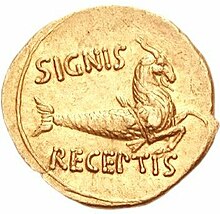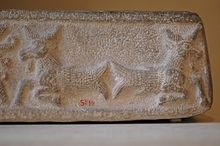Sea goat
 | |
| Grouping | Legendary creature |
|---|---|
| Sub grouping | Hybrid |
| Folklore | Greek mythology, Jewish folklore, Sumerian mythology |
| Habitat | The ocean |
The sea goat or goat fish is a legendary aquatic animal described as a creature that is half-goat and half-fish.[2]
Babylonian goat fish
[edit]
The goat fish symbolized the Babylonian god Ea. According to the Babylonian star catalogues the constellation MUL SUḪUR.MAŠ was 'the goat fish'. This constellation later became the Greek and Roman Capricornus.[3][4][unreliable source?]
Greek interpretation
[edit]The Greek interpretation of the sea goat comes from the introduction of the Babylonian zodiac. In an attempt to codify the constellation Capricornus within the Greek pantheon, two myths were used as an explanation. One being that the constellation is Amalthea, the goat that raised Zeus. As thanks for caring for him as a child, Zeus places her amongst the stars.[5]
The other being that the sea goat is the wilderness god Pan.[6] The myth goes that Pan jumped into the river to escape the monster Typhon. He tries to turn himself into a fish while jumping into the river, but he moves too quickly and only his lower half becomes that of a fish. Zeus then engages in combat with the monster. Zeus defeats him, but not without Typhon pulling the muscles out of Zeus' legs. With the help of Hermes, Pan replaces the damaged muscles. As a reward for healing him, Zeus placed Pan in the sky as Capricorn.[7] The god Aegipan is also depicted in Greek art as a sea goat.
Imagery found at Aphrodisias, including coins dating back to the 3rd century AD, depict the goddess Aphrodite riding a sea goat.[8]
Jewish tradition
[edit]In Jewish oral history, sea goats are mentioned. The story goes that one day all the creatures of the sea must offer themselves to the monster Leviathan. It is reported that a sailor encountered a sea goat while far at sea. On its horns was carved the sentence, translated as "I am a little sea-animal, yet I traversed three hundred parasangs to offer myself as food to the leviathan."[9]
See also
[edit]References
[edit]- ^ Tamsyn Barton (1995). "Augustus and Capricorn: Astrological Polyvalency and Imperial Rhetoric". The Journal of Roman Studies. 85. Society for the Promotion of Roman Studies: 47.
- ^ "The Capricorn goat/sea goat". Mythology. Gods and Monsters.
- ^ Rogers, John H. (1998). "Origins of the ancient constellations: I. The Mesopotamian traditions". Journal of the British Astronomical Association. 108: 9–28. Bibcode:1998JBAA..108....9R.
- ^ Espak, Peeter (2006). Ancient Near Eastern Gods: Enki and Ea: Diachronical Analysis of Texts and Images from the Earliest Sources to the Neo-Sumerian Period (PDF) (Masters). University of Tartu. p. 104.
- ^ Hatziminaoglou, Y.; Boyazoglu, J. (February 2004). "The goat in ancient civilisations: from the Fertile Crescent to the Aegean Sea". Small Ruminant Research. 51 (2): 123–129. doi:10.1016/j.smallrumres.2003.08.006. ISSN 0921-4488.
- ^ Andrews, Tamra (2000). Dictionary of Nature Myths: Legends of the Earth, Sea, and Sky. Oxford University Press. p. 31. ISBN 978-0-19-513677-7.
- ^ Brown, Douglas (March 1999). "Legends of the Earth, Sea, and Sky: An Encyclopedia of Nature Myths99142Tamra Andrews. Legends of the Earth, Sea, and Sky: An Encyclopedia of Nature Myths. Santa Barbara and Oxford: ABC‐Clio 1998. xiii + 322 pp, ISBN: 0 87436 963 0 £39.95". Reference Reviews. 13 (3): 19. doi:10.1108/rr.1999.13.3.19.142. ISSN 0950-4125.
- ^ Lisa R. Brody, under the direction of Christopher Ratté, "The Iconography and Cult of the Aphrodite of Aphrodisias" (dead link- archive version here), New York University, Institute of Fine Arts, 1999. (google books link)
- ^ Louis Ginzberg. (1909) Legends of the Jews. Entries: Vol I, "The Creation of the World: The Sixth Day" and Vol IV, "Elisha and Jonah: Jonah in the Whale". [1]
